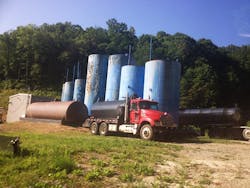Numerous headlines appeared in recent weeks about oil and gas wastewater disposal wells, which are the subject of ongoing scrutiny about whether they contribute to increased seismic activity and possible water contamination in producing states.
Studies in scientific journals outlined evidence that chemicals from unconventional natural gas operations reached a stream near a Lochgelly, W.Va., wastewater site featuring an injection well, holding ponds, and storage tanks.
A US Geological Survey scientist led a team of researchers from the University of Missouri and Duke University. They tested water samples downstream of the disposal site, finding chemicals believed to have come from shale gas wells and coalbed methane operations.
wastewater from unconventional natural gas production in
West Virginia. Photo by Kalla Leigh Fleger
of US Geological Survey.
Testing showed water and sediment samples collected downstream from the disposal site had higher salt levels, radioactive compounds, and chemicals that disrupt hormones, compared with upstream samples.
The exact source of the surface water contamination was not identified. Researchers stopped short of addressing whether the surface contamination came from the injection well.
"Deep-well injection is widely used by industry," said USGS scientist Denise Akob. "Our results demonstrate that activities at disposal facilities can potentially impact the quality of adjacent surface waters." She called for additional research.
Scientists analyzed samples for chemical markers associated with unconventional oil and gas wastewater. These include sodium, chloride, strontium, lithium, and radium. In addition, scientists analyzed microbial communities in sediments downstream.
The US Environmental Protection Agency regulates Class II injection wells, used to inject brine and other fluids associated with oil and gas production. USGS is researching possible risks to water quality and environmental health posed by waste materials from unconventional development.
Groups sue EPA
Separately, various groups filed a federal lawsuit against EPA in early May, asking for court-established deadlines that would force EPA to comply with an overdue schedule to update waste disposal rules.
The groups want EPA to adopt stricter rules on disposal wells, particularly waste from drilling and hydraulic fracturing. Most injection wells associated with oil and gas are in Texas, California, Oklahoma, and Kansas.
"These rules are almost 30 years overdue," said Adam Kron, senior attorney at the Environmental Integrity Project, which was one of the groups filing the lawsuit in the US District court for the District of Columbia. Other groups involved were the Natural Resources Defense Council (NRDC), Earthworks, Responsible Drilling Alliance, San Juan Citizens Alliance, West Virginia Surface Owners' Rights Organization (WVSORO), and the Center for Health, Environment & Justice.
Julie Archie, WVSORO project manager, said West Virginia has taken steps to improve regulation, but she said the state issues permits for horizontal drilling without considering waste disposal methods.
Amy Mall, NRDC senior policy analyst, said, "Right now, companies can get rid of their toxic mess in any number of ways, from spraying it on icy roads to sending it to landfills…to injecting it underground where it can endanger drinking water and trigger earthquakes."
In 2015, EPA issued a study saying it found no evidence of widespread damage to drinking water from fracturing. Erik Milito, American Petroleum Institute group ddirector of upstream and industry operations, said controversy continues regardless of EPA's findings. "The science is sound. This is a technology that has been around" for decades and has helped boost production, he said.
About the Author
Paula Dittrick
Senior Staff Writer
Paula Dittrick has covered oil and gas from Houston for more than 20 years. Starting in May 2007, she developed a health, safety, and environment beat for Oil & Gas Journal. Dittrick is familiar with the industry’s financial aspects. She also monitors issues associated with carbon sequestration and renewable energy.
Dittrick joined OGJ in February 2001. Previously, she worked for Dow Jones and United Press International. She began writing about oil and gas as UPI’s West Texas bureau chief during the 1980s. She earned a Bachelor’s of Science degree in journalism from the University of Nebraska in 1974.


